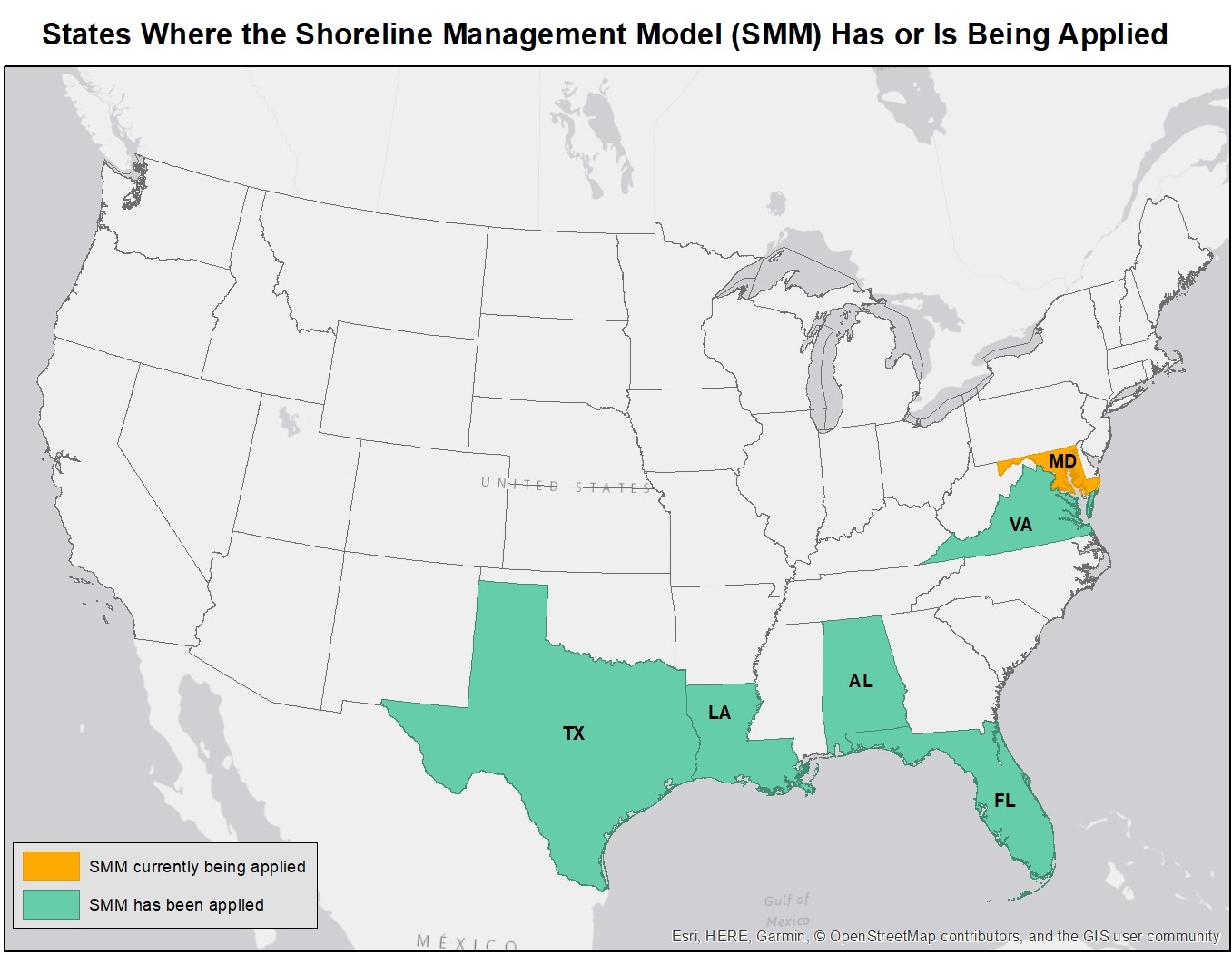Shoreline Management Model – SMM
 The Shoreline Management Model (SMM) is a geospatial data model run in ArcGIS that recommends strategies for tidal shoreline erosion control. The model output shows where living shoreline approaches may be suitable. Available information about shoreline conditions is processed through decision flow charts to reach shoreline stabilization recommendations. Model output can be viewed and analyzed with interactive map viewers.
The Shoreline Management Model (SMM) is a geospatial data model run in ArcGIS that recommends strategies for tidal shoreline erosion control. The model output shows where living shoreline approaches may be suitable. Available information about shoreline conditions is processed through decision flow charts to reach shoreline stabilization recommendations. Model output can be viewed and analyzed with interactive map viewers.
Shoreline conditions factored into the Shoreline Management Model include:
- Presence or absence of natural buffers – tidal marshes, beaches, riparian forests, submerged aquatic vegetation SAV
- Bank height
- Nearshore bathymetry
- Wave exposure (fetch)
- Existing defense structures and proximity of upland development
- Other locally-based GIS data
Regional Shoreline Management Models
The SMM was originally developed for coastal Virginia with several version updates. The latest version has been customized for application in other coastal regions.
Virginia |
MarylandComing Soon |
TexasThe Texas Living Shoreline Site Suitability Model was developed by the Harte Research Institute at Texas A&M University – Corpus Christi from the original VIMS shoreline management model foundation. This model tool is made available through the Texas General Land Office Clean Coast Texas program and a related Guide to Living Shorelines in Texas. Shoreline conditions factored into the Texas Living Shoreline Site Suitability Model include:
|
Florida – Tampa BayThe Living Shoreline Suitability Model for Tampa Bay was developed in 2018 by the Florida Fish and Wildlife Conservation Commission Fish and Wildlife Research Institute from the original VIMS shoreline management model foundation. This model tool is made available through a Living Shorelines Story Map and web site. Shoreline conditions factored into the Tampa Bay Living Shoreline Suitability Model include:
|
Louisiana - Lake PontchartrainThe Lake Pontchartrain, LA Living Shoreline Site Suitability and Decision Making Tool was developed by Troy University and LA Sea Grant from the original VIMS shoreline management model foundation. This model tool is made available through an online interactive map viewer. |
Alabama – Mobile Bayhttps://www.mobilebaynep.com/assets/pdf/Living_Shorelines-12.15.16-Web.pdf |
Alabama & Florida – Pensacola Bay / Perdido Bay / Wolf Bay / Ono Island ComplexA living shoreline site suitability model and master plan for the Pensacola Bay System is in progress by Santa Rosa County and the Pensacola & Perdido Bays Estuary Program. The project will assess 175 miles of shoreline to characterize and prioritize living shoreline opportunities across local government jurisdictions as a comprehensive coastal resilience strategy. |
Related Links
- Nunez, K., Rudnicky, T., Mason, P., Tombleson, C., Berman, M. (2022). A geospatial modeling approach to assess site suitability of living shorelines and emphasize best shoreline management practices. Special Issue: Nature-based coastal defense: developing the knowledge needed for wider implementation. Ecological Engineering. 179. 106617.
- Shoreline Management Model Manual for GIS Professionals (.zip) includes handbook, definitions and toolboxes for customized versions
- Shoreline Decision Support Tool an interactive tool that combines on-site observations with Shoreline Management Model recommendations
- Tidal Shoreline Inventories shoreline conditions map used for model input
This model has been funded, in part, and at various stages, by the VIMS' Center for Coastal Resources Management, the NOAA RESTORE Science Program, and NOAA's Coastal Zone Management Program in Virginia.
